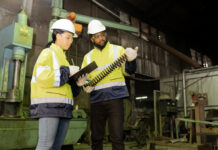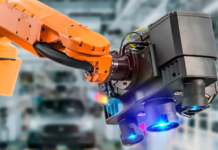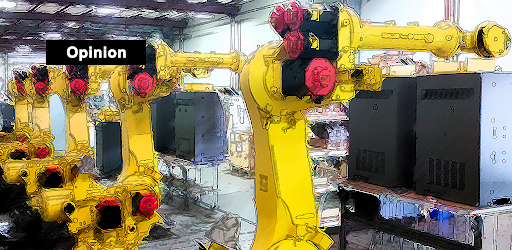Regarding robotics, the future is the present — in that it is already here. For advanced economies, robots are providing domestic companies with the efficiency edge they need to support the reshoring trend where manufacturing production returns from lower-wage manufacturing outsourcers located in other parts of the world. Welcome to the Robot Revolution!
But you cannot simply deploy robots into existing manufacturing plants and expect things to move smoothly. Plants must be retrofitted or even redesigned to make the most effective use of this new 24/7/365 workforce. Additionally, new plants should be built around robotic operations to ensure safe and smooth workflows throughout the facility.
Consider an aerospace or defense manufacturer that is preparing to build or renovate a facility they plan to use for the next 10, 20, 30 years or longer for multiple product lines. That building and infrastructure need to be future-proofed to ensure that, as well as being suitable for current work processes, they’ll be adaptable and cost-efficient for the newer processes that are coming.
Partnering with a key robotics integrator in the planning phase is a crucial step to ensure your company has the correct floorspace, excess utilities and electrical expansion capabilities. This will also help to avoid common problems like having to upgrade a brand-new building because no one asked the right questions.
Here are four ways in which aerospace and defense manufacturers can prepare for the robot revolution:
1. Leave Disappointments in the Past
Robots have been available for years, and perhaps your company has tried them in the past, with results that did not impress. If so, do not remain anti-robot. Today’s robots are already better than the ones that let you down yesterday, and tomorrow’s robots will be even better still.
Plus, it is not the robot that failed, but the process. All good robotic integrations are process driven with clear expectations established. If those aren’t clear at the beginning of the project, it probably won’t be very clear at the end either. If the process still needs to be defined, the best place to figure it out is in the lab. At our robotics company, we leverage our in-house lab on almost every project to eliminate any potential risk. The lab can be used as an early technology demonstrator before the project gets started. This is the lowest risk and cheapest route to a successful robotic system.
2. Future-Proof Your Infrastructure
Even if your company will not be using robots much in the short term, you should take their needs into account when building a new manufacturing plant or refitting an existing one. By making minor adjustments to ensure your plant is robot-future friendly, you can spare yourself the major expense of having to do a total rebuild or refit in five, 10 or 15 years from now. Building the “Factory of the Future” begins today.
Robots consume a lot of power and companies need the grid to support them. Along with the robot, all the ancillary equipment has some hefty power requirements. It’s safe to estimate a traditional industrial at peak usage will use 30 amps at 480 volts and the newer collaborative robots can run off of 20 amps at 120 volts. When you start pairing multiple robot cells together, it can add up quickly.
As robots become smarter and are being integrated with more sensors, they have more data that they’re harvesting. What good is all that data if it’s stuck on a PC? Setting up a network for your robots to operate on is more than just plugging in an Ethernet connection. Automation equipment and robots need their own independent network to communicate with each other. Working with your robotics partner to set up a system network diagram early on will help you and your IT team understand the network needs for the robotic systems.
3. Hire the Right Humans
As more aerospace and defense manufacturers integrate robots into their work processes, their human workers need to include the right combination of computer- and mechanical-savvy operators. A good robotic system operator needs to be comfortable sitting behind a computer or a teaching pendant, but also knowledgeable enough to troubleshoot a system alarm on the robot. Do not neglect mechanical or software engineers either, because robot support teams require both. These should be skilled operators who understand the process, whether it’s painting, drilling or machining. Also, maintenance personnel who understand the equipment are a must, regardless of whether they’re internal or in partnership with your integrator.
There remains a fear among some that robots will take more jobs away from humans than they create, but the World Economic Forum predicts that this will not be the case. The jobs that will be eliminated are largely the ones that are the least attractive for humans, or that had previously been shipped offshore. They will include positions that are unsafe, repetitive or that must be performed in extreme temperatures – so-called “3D” jobs that are dangerous, dull or dirty. The jobs that the robot revolution will create for humans will be more highly skilled, interesting and challenging – and ultimately more satisfying.
4. Make Your Robot Fleet Flexible
Don’t be afraid to think big. Your manufacturing needs will change – day-to-day, project to project and over time. So, when you invest in robots, invest in applications that the robot will be doing today and possibly doing in the next few years. Might you be using mobile robots, automated guided vehicles or, even, mobile multi-use robots for new, advanced projects and products? Consider what these robots could be doing in the next five or 10 years and how else they can be utilized in the future. Talk to your integrator about what robot is best for the application needed and what other potential applications are best for your robot.
Be specific about what you want the robots to do, have a broad vision for your robotics solution and group your robotic operations together. A robot that has the ability and power to pick up heavy weights might not be the same robot that’s needed for more delicate projects like precision painting. Think about how you want your robots to function and the multiple tasks you might require of them before committing to buying a fleet of robots.
Final Thoughts on the Robot Revolution
Companies can and will save substantial amounts of money by taking the requirements of a robotic future into consideration when making business decisions today. Ultimately, businesses that do not embrace this robot revolution will be left to play catch-up when robots become indispensable in helping manufacturers stay competitive and innovative. Start the process for your plant or facility now so that you’re a part of the revolution, rather than being upended by it later.
About the Author
 Josh Tuttle is the Business Development Manager at Aerobotix, an innovative leader in advanced metrology and robotic solutions for the aerospace and defense industries. The company specializes in the creation of cutting-edge automated robotic solutions for high-value, high-precision components, aircraft and vehicles.
Josh Tuttle is the Business Development Manager at Aerobotix, an innovative leader in advanced metrology and robotic solutions for the aerospace and defense industries. The company specializes in the creation of cutting-edge automated robotic solutions for high-value, high-precision components, aircraft and vehicles.




















